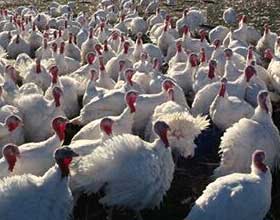Reducing salmonella in turkeys reduces human cases

Reduction targets for Salmonella in turkeys to further reduce human cases, says EFSA. The European Food Safety Authority (EFSA) was asked by the European Commission to evaluate the impact on public health of reducing Salmonella levels in turkeys across the European Union (EU).
In a new scientific opinion, experts from EFSA’s Panel on Biological Hazards identify the main Salmonella serovars in turkeys and indicate that transmission from breeding stock to fattening flocks is an important source of Salmonella infection as well as such sources as contaminated feed or turkey houses.
Through the use of a modelling tool and the analysis of harmonised EU-wide data on Salmonella in animals and on reported cases of human salmonellosis, the Panel estimated the relative public health impact of Salmonella transmitted to humans from four different animal sources: turkeys, broiler hens, laying hens and pigs.
Reducing salmonella levels
A reduction of Salmonella levels in 2012 to 1% or less for all the serovars considered in the model in fattening turkey flocks would result in an estimated 2.2% reduction across the EU of all cases of human salmonellosis compared to 2010.
The Panel emphasised that the individual EU Member States’ contributions to the estimated reductions vary greatly.
Targets are being set for the reduction of certain Salmonella serovars in different poultry populations and in pigs within the framework of EU legislation on the control of zoonotic diseases.
Among the recommendations on data gathering and surveillance measures, the Panel highlights the need to enhance active surveillance in all EU Member States in order to better estimate the true incidence of human salmonellosis.
Human salmonellosis cases may not always be identified as such and can also go unreported.
Model approach
A ‘Turkey Target Salmonella Attribution Model’ (TT-SAM) based on the microbial-subtyping approach was used to determine the quantitative contribution of turkeys and other major animal-food sources to the burden of human salmonellosis in the European Union.
It estimates that 2.6 %, 10.6 %, 17.0 % and 56.8 % of the human salmonellosis cases are attributable to turkeys, broilers, laying hens (eggs) and pigs, respectively.
The top-6 serovars of fattening turkeys that contribute most to human cases are:
S. Enteritidis,
S. Kentucky,
S. Typhimurium,
S. Newport,
S. Virchow and
S. Saintpaul.
Vertical transmission of Salmonella as well as hatchery acquired Salmonella contamination originating from breeding stock are very important sources for Salmonella infection in turkeys, and therefore controlling
Salmonella in breeding flocks as well as in rearing and fattening flocks is necessary to minimise Salmonella in turkeys at slaughter.











